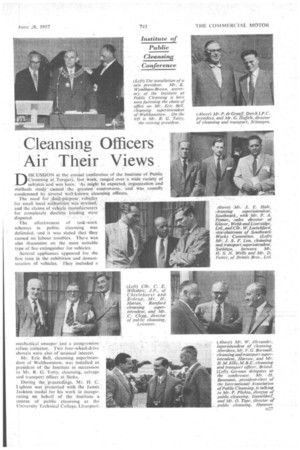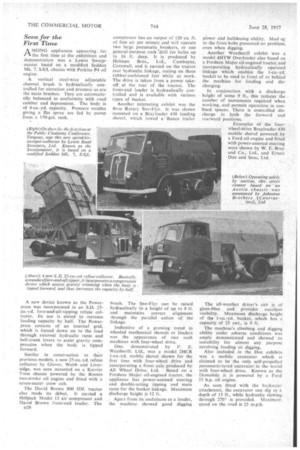Cleansing Officers Air Their Views.
Page 83

Page 84

If you've noticed an error in this article please click here to report it so we can fix it.
D ,scuss,. at nst the annual conference of the Iitute of Public Cleansing at Torquay, last week, rangedover a wide Variety of subjeCts.and wa-s keen. A.; mieht be expected. organization and methods study" cauSed --the greatest ' controversy, and Was roundly condemned by Several well-kriciWn cleansing officers. The need for' ,dual-purpose, vehicles. for small local authorities was streised, and the claims of vehicle manufacturers for completely dustless loading were disputed.
The effectiveness of task-work schemes in public cleansing was defended, and. it was stated that they caused no labour troubles. There was also discussion on the most suitable type of fire-extinguisher for vehicles.
Several appliances appeared for the first time in the. exhibition and demonstration of vehicles. They included a mechanical sweeper and a compression refuse colleetor. Two four-wheel-drive shovels were also of unusualinterest.
Mr. Eric Bell, cleansing superintendent of Walthamstow. was installedas president of the Institute in succession to Mr. R. G. Totty, cleansing, salvage and transport officer at Stoke. .
During the ,proceedings, Mr. H. C. Lighten was presented with the James" Jackson medal for his work in inaugurating on behalf of the Institute a course of public cleansing at the University Technical College, Liverpool.
Seen for the First Time
AMONG appliances appearing for the first time at the exhibition and demonstration was a Lewin Sweepmaster based on a modified Seddon Mk. 7, S.8/L chassis with Perkins P4 oil engine.
A vertical steel-wire adjustable channel brush is hydraulically controlled for elevation and pressure as are the main brushes. They are automatically balanced in conformity with road camber and depressions. The body is of 4-cu.-yd. capacity. Pressure nozzles giving a flat spray are fed by pump from a 170-gal. tank.
A new device known as the Powerpress was incorporated in an S.D. 25cu.-y d. fore-and-aft-tipping refuse collector. Its use is stated to increase loading capacity by half. The Powerpress consists of an internal grid. which is forced down on to the load through external hydraulic rams and bell-crank levers to assist gravity compression when the body is tipped forward, Similar in construction to their previous models, a new 25-cu.-yd. refuse collector by Glover, Webb and Liversidge, was seen mounted on a Karrier 7-ton chassis powered by the Rootes two-stroke oil engine and fitted with a seven-seater crew cab.
The David Brown 900 IDL tractor also made its debut. It carried a Holpack Model 13 air compressor and David Brown front-end loader. The
D28 compressor has an output of 120 Cu. ft. of fret air per minute and will operate two large pneumatic breakers, or one general-purpose rock 'drill for holes up to 16 ft. deep. It is produced by Holman Bros., Ltd., Canaborne, Cornwall, and is carried on the tractor rear hydraulic linkage, resting on three rubber-cushioned feet while at work. The drive is taken from a power takeoff at the rear of the tractor. The front-end loader is hydraulically controlled and is available with various types of bucket.
Another interesting exhibit was the Bros Rotary Sno-Flyr. It was shown mounted on a Brayloader 430 loading shovel, which towed a' Mince trailer brush. The Sno-Flyr can be raised hydraulically to a height of up to 9 ft. and maintains correct alignment through the parallel action of the linkage.
Indicative of a growing trend in wheeled mechanical shovels or binders was the appearance of two such machines with four-wheel drive.
One, demonstrated by F. E. Weatherill. Ltd., was a model 2HCR 1-cu.-yd. mobile shovel shown for the first time with four-wheel drive and incorporating a front axle produced by All Wheel Drive, Ltd. Based on a Fordson Major oil-engined tractor, the appliance has power-assisted steering and double-acting tipping and main rams for the bucket linkage. Maximum discharge height is 12 ft.
Apart from its usefulness as a loader, the machine showed good digging pOwer and bulldozing ability. Mud up to the front hubs presented no problem, even when digging.
Another Weatherill exhibit was a model 4HTW Overloader also based on a Fordson Major oil-engined tractor and incorporating hydraulically operated linkage which enables the 1-cu.-yd. bucket to be used in front of or behind the machine for loading and discharging.
In conjunction with a discharge height of some 9 ft., this reduces the number of movements required when working, and permits operation in confined spaces. There is controlled discharge in both the forward and rearward positions.
Examples of the fourwheel-drive Brayloader 430 mobile shovel powered by a Ford oil engine and fitted with power-assisted steering were shown by W. E. Bray and Co., Ltd., and Ernest Doe and Sons, Ltd.
The all-weather driver's cab is of glass-fibre and provides excellent visibility. Maximum discharge height of the 1-cu.-yd. bucket, which has a capacity of 25 cwt., is 9 ft.
The machine's climbing and digging ability under adverse conditions was amply demonstrated and showed its suitability for almost any purpose involving loading or digging.
Also included in the Doe exhibits was a mobile excavator which is claimed to be the only self-propelled pneumatic-tyred excavator in the World with four-wheel drive. Known as the Domobile it is powered by a Ford 55 h.p. oil engine.
As seen fitted with the backacter attachment, the excavator can die to a depth of 13 ft., while hydraulic slewing through 270° is provided. Maximum speed on the road is 25 m.p.h.








































































































































